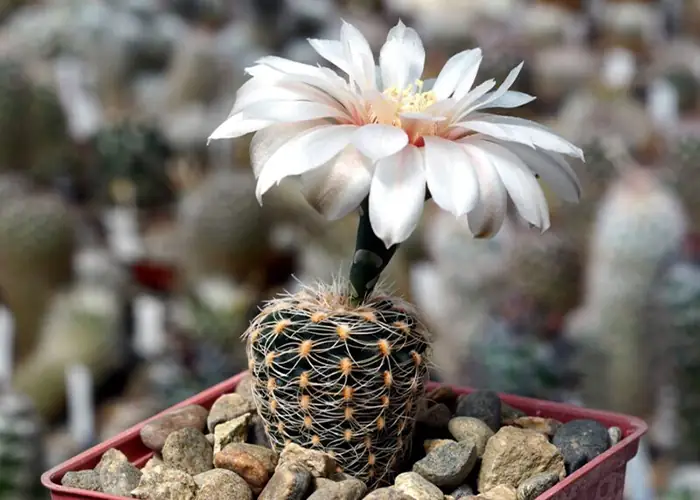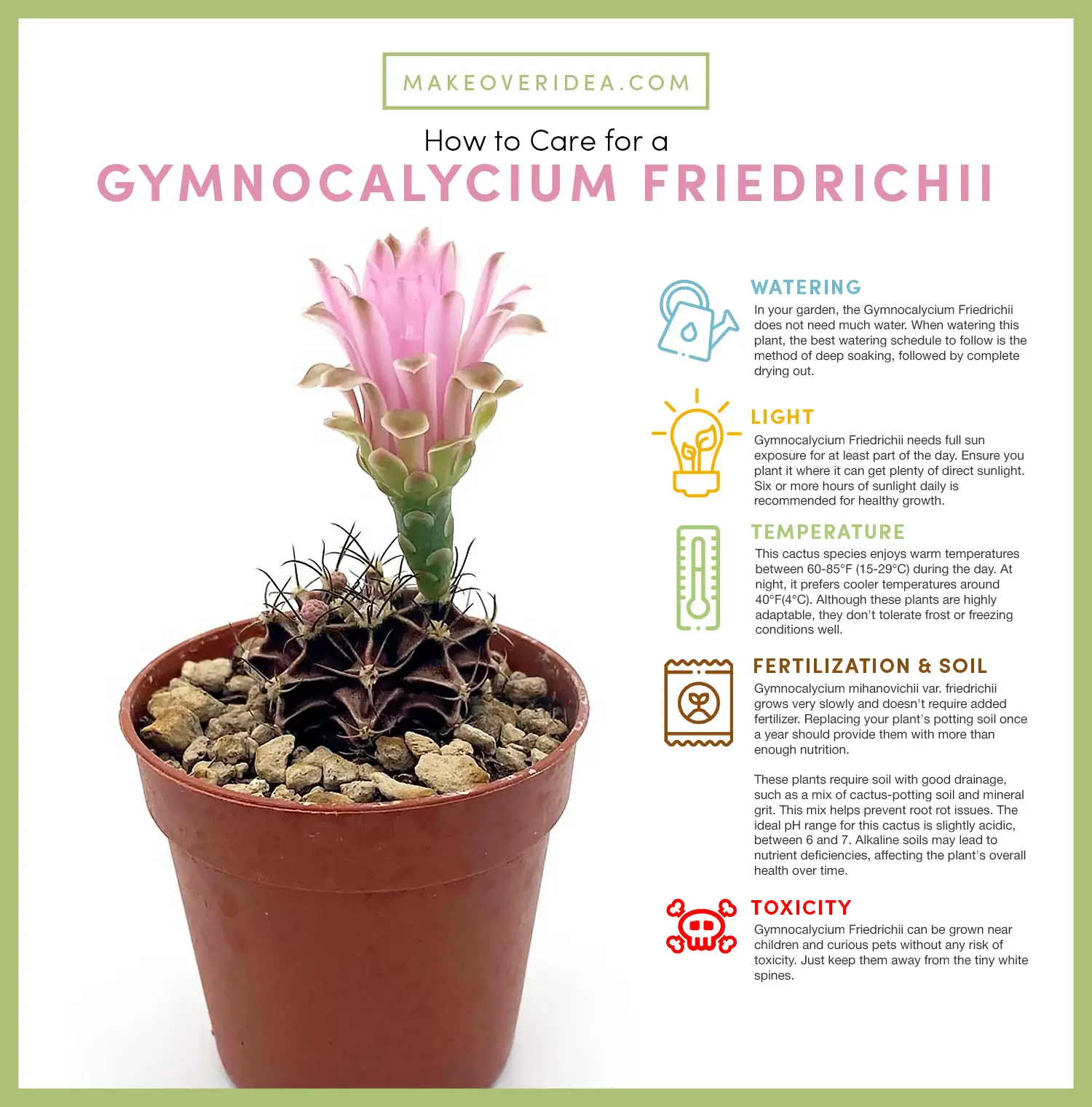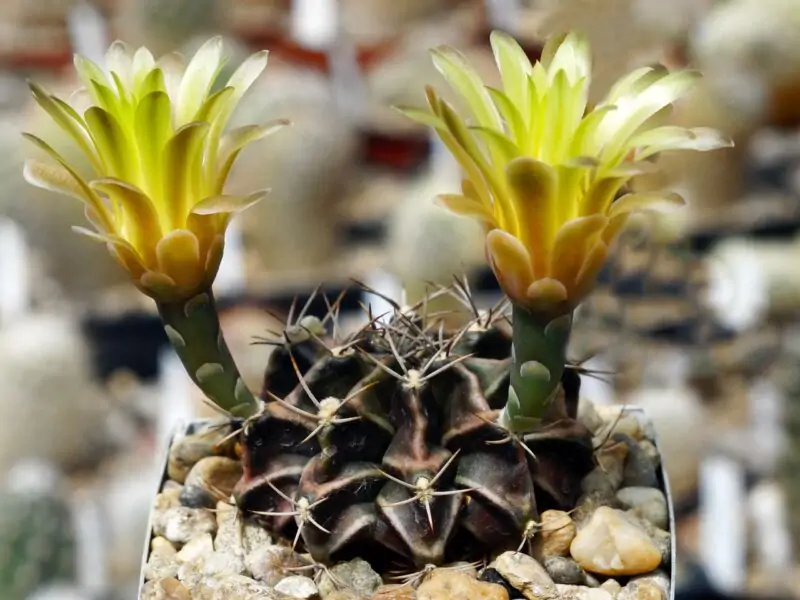Gymnocalycium Friedrichii Cactus Plant: Propagation & Care Guide

If you’re in search of a unique addition to your plant collection, the Gymnocalycium Friedrichii is a fantastic choice! This cactus species, with its banded body, sharp spines, and wide-open flowers, stands out. However, before you bring one home, you should understand its specific care needs and characteristics.
In this article, we’re covering everything from ideal growing conditions to propagation methods. So, grab your favorite beverage and let’s dive in!
Understanding Gymnocalycium Friedrichii
Origin and Natural Habitat
The Gymnocalycium Friedrichii is a native of Paraguay. However, due to its popularity as an ornamental plant, it’s found worldwide. In nature, these plants grow on rocky hillsides with good drainage.
Physical Characteristics
This dwarf cactus grows up to 3.5 inches tall. It has a globose shape, widening at the top. It resembles a tiny chin-cushion! The cactus prefers full sun exposure. This exposure helps it develop well-formed specimens with strong dark brown markings, especially when young. Sometimes, it also has crossbands of lighter colors.
Gymnocalycium Friedrichii also produces bright olive-green colored flower buds. These buds open fully upon blooming to display pinkish-purplish petals. The spines along the roller-shaped prominent ribs decorated by thickening around areoles show a well-pronounced polymorphism.
Varieties and Hybrids
There are many varieties within the Gymnocalycium Friedrichii species. They range from reddish-brown shades much like the red we see in the fall foliage of trees, to dark grape-like tones. Some varieties do not contain chlorophyll in the lower parts, called stocks. These are used mainly for grafting onto other cacti which have chlorophyll. This process provides sugar, a crucial survival component, through photosynthesis during daylight hours.
Optimal Growing Conditions

Light Requirements
Gymnocalycium Friedrichii needs full sun exposure for at least part of the day. Ensure you plant it where it can get plenty of direct sunlight. Six or more hours of sunlight daily is recommended for healthy growth.
Temperature and Humidity
This cactus species enjoys warm temperatures between 60-85°F (15-29°C) during the day. At night, it prefers cooler temperatures around 40°F(4°C). Although these plants are highly adaptable, they don’t tolerate frost or freezing conditions well.
Humidity requirements are low, as this is a desert-type succulent. It thrives best with humidity levels below 50%. If you live in a high-humidity area, ensure there is adequate air circulation around your Gymnocalycium Friedrichii.
Soil Type and pH
These plants require soil with good drainage, such as a mix of cactus-potting soil and mineral grit. This mix helps prevent root rot issues. The ideal pH range for this cactus is slightly acidic, between 6 and 7. Alkaline soils may lead to nutrient deficiencies, affecting the plant’s overall health over time.
Watering Gymnocalycium Friedrichii
Watering Frequency
When watering Gymnocalycium Friedrichii, deep soaking followed by complete drying works best. During summer months, water twice per month. Reduce the frequency to once every two or three weeks in winter, depending on how dry the potting mix feels. Each environment varies due to factors like temperature changes.
It’s crucial not to overwater them, as their roots cannot handle too much moisture. Overwatering could lead to root rot, so always check the moisture level carefully!
Signs of Overwatering and Underwatering
When it comes to caring for the Gymnocalycium Friedrichii, striking a balance with watering is vital. Here are the key signs to look out for:
Overwatering
If the leaves of your Gymnocalycium Friedrichii are turning pale or brownish-yellow, it could be a sign of overwatering. In addition, the soil might give off an unpleasant odor.
Underwatering
On the other hand, if the leaves turn yellowish-green or brownish-yellow and show a wilted appearance, your plant is likely underwatered. In this case, your plant needs more water.
Tips for Proper Watering
Water your Gymnocalycium Friedrichii deeply. This allows the roots to soak up all of the moisture they need before drying out completely. Avoid letting any excess water sit in the pot. This could cause root rot issues over time.
Feeding and Fertilizing
Nutrient Needs
Compared with other plants, Gymnocalycium Friedrichii requires minimal nutrients due to their small size and slow growth rate. A well-draining soil mix with added minerals like phosphorus, nitrogen, and potassium, along with trace elements like magnesium, promotes healthy growth at all stages, from seedling to maturity.
Types of Fertilizer
Use a cactus-specific fertilizer during the growing season, which is typically in the spring and summer. Avoid feeding them during the winter months when they are dormant. Overfeeding can lead to nutrient burn and even kill the plant.
Fertilizing Schedule
Frequent fertilization isn’t necessary for this cactus species. Aim to apply fertilizer every two to three weeks while watering regularly. This will help avoid the build-up of salts that can affect the plant’s overall health over time.
Pruning and Repotting Gymnocalycium Friedrichii
When to Prune and Repot
Pruning should only happen once a year, around springtime, just before the onset of the blooming period. This is after flowering has stopped. Cutting back dead or damaged parts promotes new growth, improving the plant’s overall appearance.
The Gymnocalycium Friedrichii typically requires repotting every two years, depending on how fast the plant matures. Use fresh cactus potting soil and add mineral grit to ensure good drainage with each cycle.
How to Prune Safely
Always use sterile pruning tools with a clean, sharp blade to prevent infections. Cut back any dead or diseased stems and leafy growth.
Choosing the Right Pot and Soil for Repotting
When repotting, select a pot that’s slightly bigger than the current one. Avoid choosing a pot that’s too big as excess soil retains more moisture, which could lead to root rot. Use well-draining cactus potting soil mixed with mineral grit to help prevent root rot issues.
Dealing with Pests and Diseases
Common Pests
Gymnocalycium Friedrichii may be susceptible to common pests like mealybugs, spider mites, and scale insects. If left untreated, these pests can significantly affect the plant’s health.
Prevention
Remove any affected parts as soon as you notice them. Keep your plants free of debris around their base area where bugs may hide, thriving in moist and dark places.
Treatment
Use insecticidal soap sprays recommended by your local nursery store. Avoid using harsh chemicals that may harm humans or pets nearby.
Common Diseases
Root Rot
Root rot is a common problem for many types of plants, and Gymnocalycium Friedrichii is no exception. This disease is usually caused by overwatering, which creates a damp environment that encourages the growth of harmful fungi and bacteria.
Prevention:
To prevent root rot, ensure your cactus is planted in well-draining soil and avoid overwatering. It’s also important to make sure your pot has adequate drainage holes at the bottom.
Treatment:
If you suspect root rot, remove your cactus from its pot and cut away any rotten roots. Then, repot the plant in fresh soil, ensuring the new pot has good drainage.
Fungal Infections
Fungal infections can affect the health of your Gymnocalycium Friedrichii. These infections usually present as discolored spots on the cactus or a powdery white substance on its surface.
Prevention:
Fungal infections can be prevented by maintaining good airflow around your cactus and avoiding overwatering.
Treatment:
Fungicides can be used to treat fungal infections. Always follow the instructions on the product label when using these treatments.
Propagation of Gymnocalycium Friedrichii
Propagation Methods
Gymnocalycium Friedrichii can be propagated using two main methods: stem cuttings and grafting. Both methods involve taking a part of the parent plant and allowing it to grow into a new plant.
Step-by-step Propagation Guide
- Choose a healthy parent plant with strong stems.
- Cut off a stem segment that is at least 3 inches long. Use a sterilized tool to make the cut.
- Allow the cut end of the stem segment to dry out completely. This process, known as “callousing,” helps prevent rot when the cutting is planted.
- Plant the calloused stem segment in a pot filled with well-draining soil. Make sure the soil is kept moist, but not waterlogged.
- Place the pot in a warm, well-lit location and wait for the new plant to grow.
Tips for Successful Propagation
Always use sterilized tools to prevent infection. Keep your propagation area clean and free of debris, which can harbor pests. Avoid overwatering your cuttings, as this can cause them to rot. Maintain a suitable temperature and light level to encourage growth.
FAQs
Gymnocalycium Friedrichii is a dwarf cactus species from Paraguay. It’s popular worldwide as an ornamental plant due to its unique appearance and ease of care.
Care for your Gymnocalycium Friedrichii by providing plenty of direct sunlight, planting it in well-draining soil, and watering it regularly but sparingly. This cactus also appreciates a humid environment, but it can tolerate dry conditions if necessary.
Yes! You can propagate Gymnocalycium Friedrichii by taking stem cuttings or by grafting it onto another cactus.

Conclusion
In conclusion, the Gymnocalycium Friedrichii is a unique and attractive cactus that makes a great addition to any plant collection. With proper care, it can thrive and bring a touch of desert beauty into your home. Remember to provide your plant with plenty of sunlight, water it sparingly, and keep an eye out for common pests and diseases. With these tips in mind, you’re well on your way to becoming a successful Gymnocalycium Friedrichii caretaker. Happy planting!